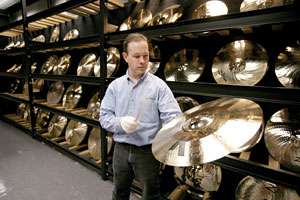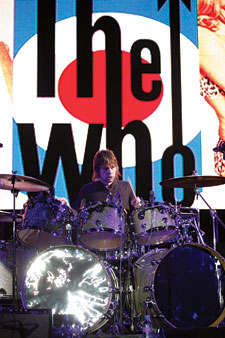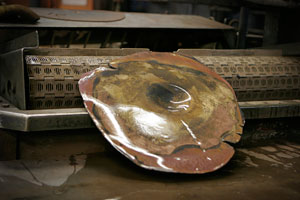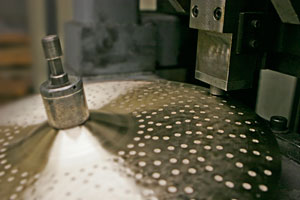The Legacy of Zildjian Cymbals Signature Sound Lives On
 Paul Francis is Zildjian's Director of Research and Design.
Paul Francis is Zildjian's Director of Research and Design.Photograph courtesy of Avedis Zildjian Company, Inc.
Zildjian, today’s leading US manufacturer of cymbals known throughout the music world and beyond, has been using the same secret alloy since they were established by Avedis Zildjian I himself in 1623.
“He was an (Armenian) alchemist who was trying to discover gold,” by combining base metals, Paul Francis, Zildjian’s Director of Research & Design, says. In 1618, he discovered the perfect mix of copper, tin, and traces of silver to create what would become the company’s signature cymbals.
“They were thinner, more pretty than others,” Francis says. “He created cymbals of spectacular clarity and power.” As a result, Avedis received an invitation from the Sultan to make cymbals for his elite Janissary Bands. “He worked for the Sultan in the Sultan’s court.”
Avedis III brought Zildjian to America in 1929. Since its inception, the business has been passed down to Zildjian heirs for fifteen generations.
“It’s the oldest business in America for making the same product,” Francis says.
Despite its rich history, Zildjian has stayed current in the industry with the help of Francis. In his role as the Director of Research & Design, Francis wears many hats.
 Zak Starkey, a drummer with The Who, used some custom made cymbals by Zildjian for his performance at the 2012 Olympic closing ceremony in London.
Zak Starkey, a drummer with The Who, used some custom made cymbals by Zildjian for his performance at the 2012 Olympic closing ceremony in London.Photograph courtesy of Avedis Zildjian Company, Inc.
“I’m in charge of the design of any new products, the redesign of any existing products and I’m in charge of the overall quality of all cymbals made,” he says.
Francis began working at Zildjian when he was 20 years of age. Originally on a path to become a professional drummer, Francis was encouraged by his parents to get a paying job alongside performing
“I called a local drum teacher who was friends with the Zildjian family,” he says.
Francis was directed to call Craigie Zildjian, now the company’s CEO since 1999, who was the human resources manager at the time, which led him to a labor position in the factory.
“I literally started sweeping the floor the first day,” he says.
His plan, to only work there for a few months, soon changed. As he was climbing the ranks to be the Director of Research and Design, he earned a mechanical engineering degree.
Francis said that over the years, Zildjian has adapted to the needs of drummers while maintaining the high standards that have always been synonymous with the Zildjian name.
“It’s not so much to reinvent as much as understanding why we do what we do,” he says. “When we come out with something new, it is a manipulation of the metal in a different way based on sound needs of drummers today.”
Keeping their ears open has been a key to Zildjian’s success.
“We have all kinds of information coming at us either through a drummer on the street or an artist might call up with an idea,” he says.
Zildjian customizes products for many well-known drummers.
 A Turkish cymbal by Zildjian goes through the tempering process during manufacturing.
A Turkish cymbal by Zildjian goes through the tempering process during manufacturing.Photograph courtesy of Avedis Zildjian Company, Inc.
“We have made stuff for Carter Beauford of the Dave Matthews Band, Max Weinberg who plays with Bruce Springsteen,” Francis says to name a few. “Zak Starkey who plays with The Who -- we made some special cymbals for him for the Olympics because The Who closed the Olympics.”
Francis also deals with jazz drummers.
“They like to push the envelope with sound,” he says.
In some cases, they have drummers evaluate prototypes, such as a new alloy recently developed.
“It is a newer alloy to use that we haven’t used before,” Francis says. “The combination of copper and tin is different than what Zildjian has been making for almost 400 years.”
What makes it different is a lower tin content.
“80% copper and 20% tin – that is what Zildjian is famous for,” he says. “The secret is how they put it together in the manufacturing process. The more tin that you put in with the copper, the richer the sound you get out of the product.”
The Zildjian secret to producing their stellar cymbals is closely guarded, and was initially passed down only to the eldest male member of the family.
“I’m not allowed in the foundry – ever,” he says. “It is something that is taught – that has been taught from generation to generation.”
 A Turkish cymbal by Zildjian goes through the hammering process during manufacturing.
A Turkish cymbal by Zildjian goes through the hammering process during manufacturing.Photograph courtesy of Avedis Zildjian Company, Inc.
Zildjian’s foundry is located at their factory in Norwell, Massachusetts. It has very limited access.
“Four long-term employees are locked behind a door and mix the copper and the tin,” he explains.
“They pour it in a large open mold – we start with those castings and we put it in a big furnace and we will heat it up to about 1,500 degrees Fahrenheit that stress relieves the casting and then we roll it through two steel rollers and we will put it back into the oven to heat again and after heated we will roll it at a 90 degree angle –- much like pizza dough -- to get to a thinness.”
The process involves heating and rolling six to twelve times to achieve the desired thickness.
“If you tried to cold roll it, it will shatter like glass since there is so much tin in there,” he says. “It is very labor intensive to make a cymbal.”
After the metal is made soft, they are able to do the cold-working process to make it into a cymbal.
He describes what he refers to as a built-in inconsistency in the whole process.
“Each casting isn’t the exact same weight – we shoot for a range,” he says. “We try to be as consistent as possible.”
They mix the twenty percent tin bronze alloy themselves and the other, they purchase from a metal manufacturer in the U.S.
“Everything is made in the U.S.,” he says. “You can control the quality when you have your factory here. 90% of our building is manufacturing.”
Zildjian runs two, ten-hour shifts, four days a week, made up of 75 to 80 cymbal makers.
“We used to have over 100 and we have become more efficient,” he says. Years ago it used to take them twenty-two days to make a cymbal. “If we start rolling a 16” cymbal today, we could have it finished in eight to nine hours,” Francis says.
Today, Zildjian created 650 different models of cymbals.
“We make different alloys and we make sizes ranging from a 6-inch splash cymbal to a 24-inch ride cymbal” he says. Paper thin, medium thin, medium and rock are offered.
“Different thicknesses lend itself to the sounds,” Francis says. “We use several different alloys – we have three in production and a fourth one that is being prototyped.”
While Zildjian makes cymbals for everyone and caters to all genres of music, their biggest sector is the pop music drummer who is a drum set player.
“Once the Beatles were on the Ed Sullivan show in 1964, everything changed for all of the musical instrument makers,” he says. “Everyone wanted to play the drums. People revere them for the sound and that they look like works of art. Our cymbals last a lifetime if you take care of them. I have held (Zildjian) cymbals from the Vienna Philharmonic that are over 100 years old.”
Resources:
Also in this Issue:
- The Legacy of Zildjian Cymbals Signature Sound Lives On
- Slow and Steady: Nancy Worden’s Electroformed Jewelry
- Archive Designs Warms the Glow in Home Accents
- Metal Jewelry with a Sensuous Richness that Longs to Be Touched
- Frederic Remington's Lifetime Casts of Bronzes in Rare Exhibition at Sid Richardson Museum
